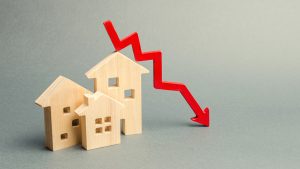China’s real estate market is in a deep downturn, with housing prices nearly matching 2015 lows. At the end of April, the country had completed and unsold properties covering 391 million square metres, equivalent in size to 6.6 Manhattans.
The volume of vacant homes signifies that real estate sales are still in the red. Zhuge Real Estate Data Research Center recently surveyed 14 cities, finding the number of homes offered for purchase was 20 times greater than earlier sales volumes. ANZ, an Australian and New Zealand Banking Group, predicts by late 2024, the overall number of unsold dwellings, including flats still being built, will be 2.9 billion square metres, or nearly twice the size of London, U.K.
Real estate price decreases, and massive numbers of unsold properties are the aftereffects of the “three-red-lines” and other Chinese government policies. In 2020, these regulations abruptly ended the high-leverage, quick turnover, and high-profitability model developers had widely been following.
The number of permits issued for the sale of new housing units in Chinese cities was significantly reduced in 2022, which had an immediate impact on housing supply. Due to restricted speculation, the demand side dramatically decreased as well. After more than 20 years of rapid growth and price appreciation, the industry reversed. An aging population and a falling fertility rate indicate future housing demand will decline even further.
The financial difficulties faced by real estate developers resulted in the recent bankruptcies of companies such as Sino-Ocean, Country Garden and Evergrande, which issued a large number of U.S. dollar bonds in Hong Kong, along with RMB (Renminbi) bonds onshore. The defaults also uncovered serious debt issues with China’s municipal governments.
The financial strain on real estate developers has been made worse by increased prices for residential land and other properties. The current slump in Chinese real estate is different from the conventional pattern of downturns, which usually involve a decline in both prices and transaction volumes. Despite a dramatic decline in sales volumes, residential land prices have increased significantly.
The real estate industry is essential to the functioning of the economy since properties are one of the main forms of collateral used to finance business investments. Historically, the industry has contributed 25-to–30-per-cent of China’s GDP. To address one of the largest current threats to its economy, the Chinese government devised a comprehensive real estate rescue package in May 2024 that eased mortgage regulations and encouraged local governments to purchase unsold properties.
Since then, major easing measures for homeowners have been implemented in three of the country’s largest cities: Shanghai, Shenzhen, and Guangzhou. These initiatives have lowered down payment requirements and increased the availability of lower-cost mortgages.
The correlation between China’s real estate industry and falling commodity prices, specifically for iron ore, indicates a slowdown in the country’s construction sector. According to Capital Economics Ltd., iron ore prices are expected to hit $100 per ton by the end of 2024 before plummeting to $85 next year, paralleling China’s housing market collapse.
A further quote from Capital Economics reads, “This year’s fall in iron ore prices is likely to have been a dress rehearsal for what’s ahead…Our China team’s forecast for the property sector to halve by the end of the decade does not bode well for iron ore producers’ plans to ramp up production.”
Similarly, a report from Fitch Ratings forecasts China’s yearly demand for new housing will fall by about 20 per cent between 2024 and 2040 to an average of 800 million square metres. This drop will be due to slowing urbanization, an aging population and a changing economic landscape. Consequently, the annual supply of new private dwellings, measured by gross floor area (GFA), may decrease to 600 million square metres.
A significant excess of unsold houses and falling property prices characterizes the Chinese real estate market today. Government regulations have changed the dynamics of the industry, putting developers under financial duress. The government recognizes the crucial role real estate plays in the economy, as seen by recent easing measures and rescue packages aimed at restoring the market.
Looking ahead, the Chinese housing sector faces a critical era requiring effective regulatory intervention at a time when weakening demographic trends and economic adjustments redefine property demand.
Dmytro Konovalov has over 10 years of experience in equity research and analysis for global markets at leading international financial institutions.








Recent Comments